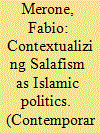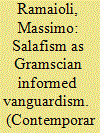|
|
|
Sort Order |
|
|
|
Items / Page
|
|
|
|
|
|
|
| Srl | Item |
| 1 |
ID:
191626


|
|
|
|
|
| Summary/Abstract |
This article examines Salafism as part of what it defines as ‘Islamic politics’, a modern phenomenon of activism and human agency based on an ideological conception of Islam—the ‘Islamic political theology of the praxis’—that is both a comprehensive vision of the world and its pro-active implementation. This article’s starting point is Wiktorowicz’s 2006 seminal article, ‘Anatomy of the Salafi movement’. This article highlights the epistemological underpinning of his work. Analysing Wiktorowicz’s broader intellectual contribution, especially his 2004 book on ‘Islamic activism’, it is possible to emphasize that Wiktorowicz was interested in epistemologically centring the study on Islamic activism (Islamism and Salafism together). From this starting point, the article argues that both Salafism and Islamism should be considered part of the practical activity of ‘doing politics’ within an ideological vision of Islam. The term proposed here is thus ‘Islamic politics’, a frame through which the development of both Islamism and Salafism is examined. In line with Wiktorowicz, this article supports the contention that the context matters, but it also argues that ideology as also a relevant factor.
|
|
|
|
|
|
|
|
|
|
|
|
|
|
|
|
| 2 |
ID:
191621


|
|
|
|
|
| Summary/Abstract |
Using the case study of Egypt’s largest Salafi movement, the Alexandrian Da‘wa Salafiyya and its party al-Nur, this article revisits Wiktorowicz’s typology which identified three dominant factions within Salafism: purists, politicos, and jihadis (2006). Based on this Egyptian case study, I show that there is no clear boundary between the purists and the politicos. This article also makes the case for an additional category: voluntary co-optation. Instead of fitting into immutable categories, Da‘wa Salafiyya leaders move between religious and political identities depending on what they deem to be the most effective strategy for political survival. Egyptian Salafis have adopted three different strategies to ensure their political survival since the movement’s inception: quietism under Sadat and Mubarak, political activism following the 2011 Revolution, and finally co-optation by the military regime since 2013. Wiktorowicz’s categories are best interpreted as time-bounded pragmatic political strategies rather than finite and static identities.
|
|
|
|
|
|
|
|
|
|
|
|
|
|
|
|
| 3 |
ID:
191624


|
|
|
|
|
| Summary/Abstract |
This article focuses on contemporary Salafism in the European context and how it speaks to the categories Wiktorowicz put forth in his seminal 2006 article. Specifically, it examines how we can identify, describe, and classify the main forms of Salafist religiosity in the context of Western European countries. Furthermore, by examining the relationship to politics, preaching, and orthodoxy and orthopraxy in several European societies, this analysis contributes to the debate on the typologies of Salafism and proposes new ways of conceiving and distinguishing the forms of attachment to this vision of Islam in the context of countries where this religion is a minority. It also shows that the fundamentalist and radical currents are even more attached to it despite or because of the strong attention they receive from the public authorities and the media.
|
|
|
|
|
|
|
|
|
|
|
|
|
|
|
|
| 4 |
ID:
191620


|
|
|
|
|
| Summary/Abstract |
This article re-examines the relevance of the typology Quintan Wiktorowicz put forth considering the process of rupture between two of three categories of Salafism he had identified: Quietist Salafism and Jihadi Salafism. Salafism is traditionally understood as the attempt of a part of the Muslim clergy to return to the fundamentals of Islam through a literalist approach. Accordingly, for several authors, jihadism has its ideological roots in Salafism. This theoretical perspective is based on the work of Wiktorowicz, according to whom there are three sensibilities or strands within Salafism (purist, political and revolutionary) when it comes to its relationship with the political. This typology, which has the epistemological merit of accounting for the plurality of the different trends in Salafism, implies that they belong to the same ideological family and that they share a common background. This approach, which has flourished in the academic literature on Islamic radicalisation, subscribes to the idea that quietist Salafism and jihadist Salafism share a common base and the same objectives, but are opposed in terms of how to achieve them: quietist Salafism focuses on preaching and jihadi Salafism on violence. However, this article questions the links between these two categories and argues that they have become increasingly weaker and have now virtually disappeared because of the political and religious events that have affected the Muslim world over the last four decades.
|
|
|
|
|
|
|
|
|
|
|
|
|
|
|
|
| 5 |
ID:
191625


|
|
|
|
|
| Summary/Abstract |
In this study, I offer a categorization of Salafism based on the concept of vanguardism. Vanguardism suggests how Salafis inhabit the political domain, by posing as the vanguard of a privileged group endowed with a historical mission. Relatedly, I summon the Gramscian concept of “philosophy of praxis.” With this, I intend to reconfigure Wiktorowicz’s classificatory scheme predicated on too stark an opposition between ‘aqīdah (theory) and manhaj (method). The philosophy of praxis accounts for the inherent tension between these two domains. Such tension is manifest in Salafis’ ambiguities, compromises, internal rifts, ideological adjustments, and revisions. Two related Gramscian concepts, historical bloc and modern Prince, bring such considerations more immediately into the political. They highlight, respectively, the political-historical context in which Salafis operate and the political-historical role they play as instances of vanguardism. I then put forth my classificatory scheme in the form of a typology. One axis is represented by the attitude towards the “historical bloc” (pro or anti) and the kind of vanguard posturing that emerges out of it (support, creation, or activation). The other axis is represented by the specific framing of the “Enemy” category on the part of the Salafi vanguard (historical/institutional or essential/identitarian), and the stance they consequently assume towards it (compromise/accommodation or rejection/denunciation). The resulting classification offers six categories (accommodationists, partisans, delayers, agitators, mobilizers, and belligerents). Stressing the fundamental political nature of contemporary Salafism—its vanguardism—they account for its inscription in a specific, modern way of thinking and acting the political.
|
|
|
|
|
|
|
|
|
|
|
|
|
|
|
|
| 6 |
ID:
191623


|
|
|
|
|
| Summary/Abstract |
Quintan Wiktorowicz’s typology and other methods of classification developed by other scholars from his approach have been the most popular when studying Salafism. However, such typologies, especially when examining Salafism in non-Middle Eastern and minority contexts, have their shortcomings. The first main problem with current typologies is that they discuss distinct Salafi factions at a specific time and local context, but intend to be universal. However, these factions often tend not to be conceptually different, as in many cases, their participants only behave differently due to different circumstances in different localities. Second, these typologies were devised by scholars who chiefly study the Middle East and distinguish different Salafi groups based on their discourses on issues often relevant only in Middle Eastern contexts. This article tests the applicability of the existing classifications of Salafism by drawing on three ethnographic case studies from Cambodia. In Cambodia, Salafism emerged in a Muslim minority context. With the expansion of its networks, fragmentation occurred within the movement due to disagreements such as how to deal with the Muslim (non-Salafi) other and the non-Muslim majority. The article argues that classifications should be set up based on observing local group dynamics instead of being universal. This is because differences among Salafis, just as in other social movements, mainly arise due to the participants’ interaction with the local realities and issues.
|
|
|
|
|
|
|
|
|
|
|
|
|
|
|
|
|
|
|
|
|